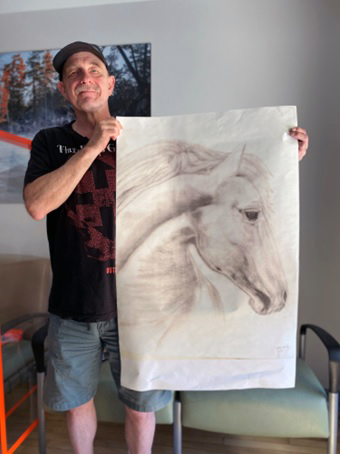The Ottawa Mission art program – making the healing power of art available to all
An interview with Aileen Leo, Director of Communications
By Robin Etherington
The Ottawa Mission’s art program supports individual artists and community engagement through exhibitions, fundraising, and partnerships with local artists and organizations. It empowers individuals, showcases their work, and raises funds for the Mission’s programs, while fostering a sense of community and belonging.
What has been the greatest challenge for the Ottawa Mission’s art program?
It faces staffing changes and working to determine the right balance between clients who want to work on their own projects and those who want to explore new modes of making art for which they need instruction. We give clients who make their art the space to do so and encourage their participation. Some clients want instruction in particular techniques, which we support.
What is the greatest challenge for the community with regard to helping the homeless in Ottawa?
Challenges entail the pandemic, job loss and mental health distress, record inflation and lack of affordable housing, resulting in the Mission stretching limited resources to ensure that these needs are met.
Homelessness and food insecurity continue to worsen. The shelter’s total number of annual meals served rose from 495,000 before the pandemic to over one million each for the past three fiscal years. Food insecurity is at an all-time high in Ottawa. High inflation, high housing costs are pushing people to meal programs.
Over five years ago, Ottawa City Council declared a homelessness emergency. In 2025, there are 3,000 homeless people, over 500 of whom are sleeping outside.
What is the Ottawa Mission’s relationship with the City of Ottawa?
The Ottawa Mission and the City of Ottawa work closely together to meet the needs of our clients. The city is the main level of government that provides support for our operations. Mostly for emergency shelter dorm beds and also meals provided at the shelter. The city also provides funds for a case worker within our housing department to help find safe, affordable and appropriate housing for our clients. City of Ottawa funding comprises about 55% of our total budget.
What are the funding resources for the Ottawa Mission and for its art program specifically?
When fully implemented, the art program will be funded entirely by donations to support the opportunity for clients to make art.
What partnerships are happening that are unique and future-oriented?
The Ottawa Mission works with the Ottawa Art Gallery (OAG) and the HeARTcare Program. OAG and Arts Court (AC) have experience working with many different constituencies, including vulnerable populations, to make art. We are open to broadening these partnerships beyond the OAG and AC, for example, the Ottawa School of Art.
We have many partnerships across programs, for example, health services programs such as our primary care clinic and hospice partner with Ottawa Inner City Health, Bruyère, and others to deliver services to clients in these programs. It would not be a stretch to expand our partnerships to our art program (for example, the art gallery at Bruyère).
How do community people participate in the Ottawa Mission?
The Mission relies on 195 volunteers per week to help deliver our 18 different programs and services to help vulnerable people rebuild their lives. We could recruit community volunteers to help with the art program.
How do you see Ottawa Mission’s art program five years?
I see a critical mass of Mission clients participating in the program in all areas of the arts – visual art, music, poetry, and drama. People who seek services or shelter are dealing with challenges in their lives. The findings from the OAG’s and Radical Connections HeARTcare Symposium in 2024 demonstrate the benefits for people engaging in making art and viewing forms of artistic expression for their physical and mental health. This is a support for people dealing with homelessness, food insecurity, mental health, and other issues.
What are the challenges and opportunities for Ottawa’ Mission’s art program?
The main challenges for all Ottawa Mission programs are finding sufficient funding for them in a very competitive environment both for fundraising and also support from various levels of government.
Destigmatizing the role of homeless shelters and what services we offer to our clients is also important. Originally the Mission only offered emergency services. Now our services include researching the reasons why people become homeless, for example, addictions and mental health challenges, and trying to address these issues before people become homeless. Since the 1990s, we’ve expanded beyond emergency services to offer employment, housing and educational support, primary, hospice, dental and eye care, job training, addiction and trauma services, mental health services, and non-denominational spiritual care. The addition of the client art program is a natural extension of this list of services to help vulnerable people rebuild their lives.
Please talk about your work with the Ottawa Mission art program.
I have had the idea of an art program for the Mission for some time, stemming from applying for the MA Therapy program at Concordia after my degree in visual arts at University of Ottawa. The benefits of engagement with art across all forms are many and I would like to bring those benefits to clients here.
How do you plan to celebrate Ottawa’s 200th Anniversary in 2026-2027?
In 2026-27 the Mission celebrates 120 years of service. We will work with partners to mount our clients’ artworks in their spaces, among other activities.
 The Ottawa Mission at 35 Waller Street.
The Ottawa Mission at 35 Waller Street. Mission client John displays his sketch of a horse.
Mission client John displays his sketch of a horse. Mission client John’s Christmas card from 2023.
Mission client John’s Christmas card from 2023.






